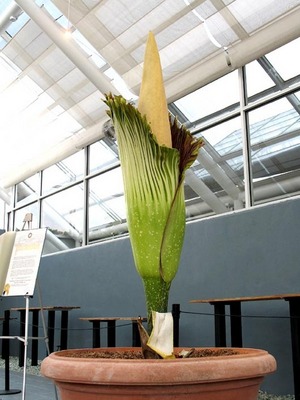"It really does smell like there's a dead body in the room," says Garden Director Paul Licht, recalling his experience with Trudy, another corpse flower that blossomed in the garden's Tropical House in July 2005. The odor helps the plant attract insects that carry its pollen to other titan arums, since corpse flowers can't pollinate themselves.

|
| ©Unknown |
| Amorphophallus titanium |
Titan arum specimens are rare enough to be named like pets. Garden staff calls their soon-to-bloom plant Titania after the Queen of the Fairies in Shakespeare's "A Midsummer's Night Dream."
Titania was raised from seed in the garden starting in 1995. Not until July 19 did Licht and his staff know their plant would be one of the rare titan arums that actually flower. On that day, Titania measured 36 ¾". By Monday morning, July 30, her spadex - the protuberance at the flower's center - had hit the 61" mark. The plant can grow up to 6" a day, notes Licht.
Before blooming, titan arum looks like a rounded column with a green pleated skirt of leaves wrapped around it. When the plant's "skirt" takes on a purple tinge, it will likely bloom two days later. And that's when the corpse odor kicks in, lasting for about 12 hours.
Visitors can enter UC Botanical Garden daily until 5 p.m., and viewing is permitted until 6 p.m. During the week, visitors are encouraged to take the campus shuttle, which leaves every half-hour from Hearst Mining Circle, since parking is very limited. More at botanicalgarden.berkeley.edu.



Reader Comments
to our Newsletter